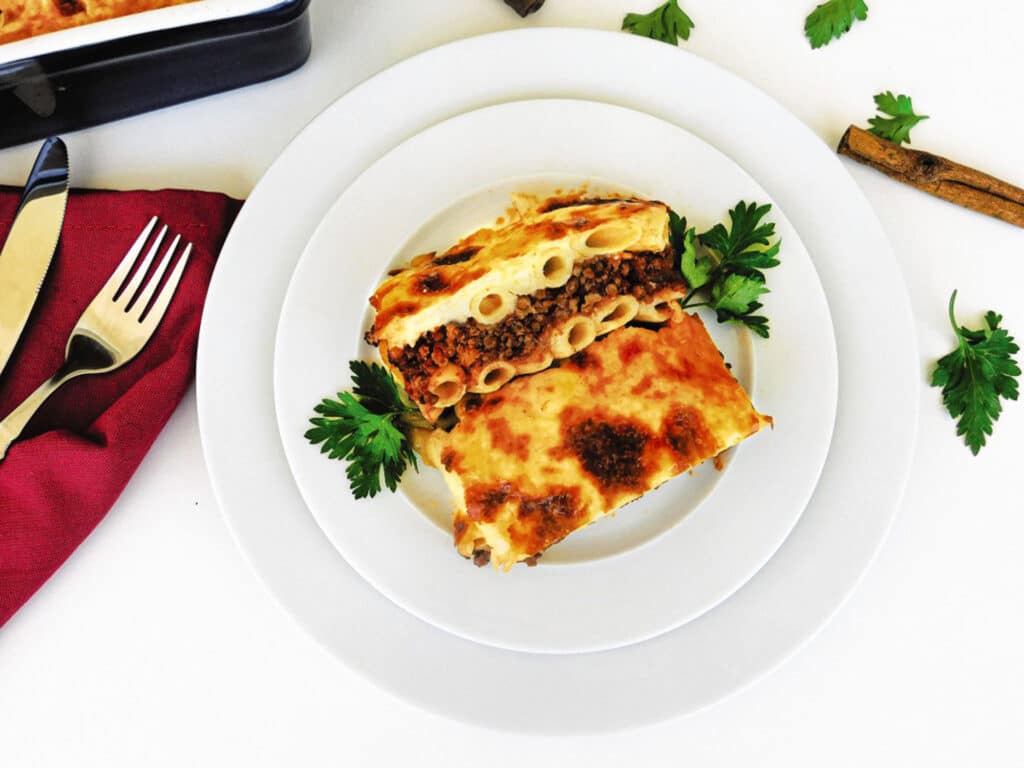
My husband, Jeff, and I were relaxing in the cockpit of Outrider, our Westsail 42, in San Carlos, Mexico, when we suddenly found ourselves talking about Greece. We were traveling happily down memory lane, reminiscing about a summer we’d spent years ago, backpacking through the Greek islands. The taste of the meal we’d just eaten at a favorite beachside restaurant in Mexico, La Palapa Griega, had brought memories flooding back. Soon, the talk turned to food.
Years ago, we’d arrived in Santorini, Greece, sleep-deprived, frazzled and hungry. Wandering off the beaten path, we’d found a quiet taverna, where we sampled pastitsio for the first time. Often called Greek lasagna, this baked, meaty casserole—layers of spiced ground beef, long tubular pasta, and a rich and creamy white-sauce topping—completely revived us. The taste of that delicious first bite has stayed with us for years.
Back home again in California, as we resumed full-time work and life aboard, I tried to re-create the dish, without success. My efforts were a little bland and dry.
Fast forward to Mexico, where (now retired) we spend every winter aboard. As full-time liveaboards for 30-odd years, the decision to sail our home south, to live our dream of cruising Mexico and the Sea of Cortez, also meant we were in a hurricane zone with scorching summers—a situation not exactly conducive to year-round living aboard. Neither of us relished the idea of living like moles belowdecks, air conditioning running, unable to venture outside during hot daylight hours. Ultimately, we decided to cruise during the cooler months and leave Outrider in capable hands, either on the hard or in a secure slip in Mexico, each summer while we headed back north.
To avoid paying double rent (a marina slip in Mexico and an apartment in the United States) we offered our services as summertime pet and house sitters to our travel-loving US friends up north. It worked. Now, though we do house-sit occasionally, we have a “liveaboard” camper van; each summer, we head north to land-cruise, camping and exploring new places every year.
Back aboard Outrider that evening, by the time the reminiscing wound down, we’d worked up a serious pastitsio jones. We made a plan: We’d return to the restaurant in a day or two, to sample their Greek lasagna.
Unfortunately, Lady Luck had other ideas. Later that evening, we heard what sounded like fire alarms in the distance, followed by an ominous dark plume of smoke wafting out over the ocean. It appeared that something rather big was ablaze, but majestic Tetakawi Mountain blocked our view.
The next day, we found out the casualty was our beloved La Palapa Griega. We wouldn’t be eating their pastitsio anytime soon.
So, I retrieved my recipe stash from a drawer, found the well-worn notes from my earlier attempts, and got busy on my Greek pasta bake. Jeff took one bite and tactfully reminded me that nothing magical had occurred over the years; the recipe was still a bit bland and dry. But, unlike before, I now had all the time in the world to tweak the recipe.
The proper pasta for this dish—thick, hollow spaghetti—is hard to find outside Greece, so I went for penne. It’s hollow and about the same diameter, just shorter. I experimented with sauce-to-meat ratios and different spices. After one more trial that didn’t quite work, the third time, like that first bite years ago in Santorini, hit the sweet spot. Flavorful, aromatic and moist, it truly was a taste of times past.
Editor’s Note: Mott reports that as of September 2022, La Palapa Griega is up and running.

Meaty Greek Lasagna, serves 6 to 8
- 10-12 oz. raw penne pasta (about 3-3 1/2 cups)
- 4 Tbsp. olive oil
- 1 cup Parmesan, grated
- 13/4 lb. ground beef
- 1 small to medium onion, chopped
- 1 24-oz. jar tomato sauce
- 1/2 tsp. salt
- 1/4 tsp. pepper
- 1/2 tsp. cinnamon
- 1/2 tsp. ground cloves
White Sauce
- 1/4 cup butter
- 1/4 cup flour
- 2 cups milk, room temperature
- 1/2 cup additional Parmesan, grated finely
- 2 egg yolks, room temperature
- Salt and pepper, to taste
Cook penne al dente according to package instructions. Drain and toss with 2 tablespoons olive oil and a little Parmesan; set aside.
In a large pan, briefly sauté beef in remaining 2 tablespoons oil. Add onions, and cook till soft and meat is browned. Do not drain fat. Stir in tomato sauce, salt, pepper, cinnamon and ground cloves. Bring to a boil, reduce heat, and simmer 20 minutes.
Grease a 9-by-13 ovenproof baking pan. Spread half of the pasta evenly on the bottom of the pan. Spread the meat sauce over the pasta in an even layer. Sprinkle with Parmesan. Spread remaining pasta on top.
Make the white sauce: In a saucepan over low heat, melt butter and slowly shake in flour a bit at a time, stirring constantly with a wooden spoon or wire whisk. Very gradually add room-temperature milk a little at a time, stirring constantly to prevent lumps. When all milk is added, continue to heat and stir until sauce begins to thicken. (This can take 10 to 20 minutes.) Add 1/4 cup Parmesan, and continue stirring. When sauce is thickened and creamy, it’s ready. Remove from heat, and let cool slightly.
Lightly beat room-temperature egg yolks in a small bowl. Take a small amount of sauce and add it to the eggs, whisking rapidly. Pour egg mix into sauce in pan, and stir vigorously to blend. Add salt and pepper to taste.
Pour sauce evenly over pasta layers. Bake at 350 degrees Fahrenheit for 30 minutes. Briefly remove from oven, top with remaining 1/4 cup Parmesan, tent loosely with foil, and bake an additional 10 to 15 minutes, or until top is golden brown and meat sauce is bubbling at the edges. Let sit 10 to 20 minutes before cutting into square pieces to serve.
Prep time: 2 hours
Difficulty: Medium
Can be made: at anchor
Cook’s Notes
To cut down on the prep time, you can use a good packaged mix for the white sauce. Leftover lasagna keeps well in the fridge for two days. Or freeze in individual portions, and reheat to eat. If anything, it gets even better.
What’s Cooking?
Do you have a favorite boat recipe? Send it to us for possible use in Sailor & Galley. Tell us why it’s a favorite, and add a short description of your boat and where you cruise. Send it, along with a high-quality digital photo of yourself aboard your boat, to sailorandgalley@cruisingworld.com








